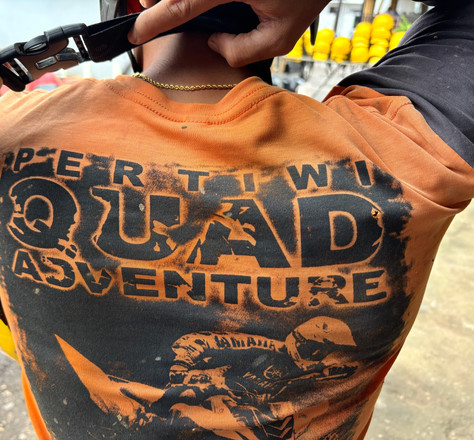At late 50s/early 60s – that time of life when there are more experiences behind you than ahead – we fight the urge of living between the jaded states of “been there, done that” or (eye roll) “Why would I bother!” One of this couple borders on the cynical and the other often wears rose-tinted glasses. Together it’s a balance of practical and dreamer plans with the common goal to keep shaking things up -- travel being the conduit. This is how a spreadsheet for 11 months on the road evolved including ways to push ourselves and try a few things many have already experienced back in their 20s. There will be some backpacker style accommodations, coastal walks, snorkelling, campervans, cheap buckets of beer and maybe even a late night or two. It’s all unapologetically hedonistic but brings us closer and keeps this 30-year relationship fresh. Our 4th trip to Bali, this time for a month, set the stage with everything we needed to disconnect from life-in-the-city and create the unexpected daily rhythms of life-out-of-a-suitcase. Familiar enough, yet still unique with a never- ending feast for the senses.
As self-described beach people, we “chase the fun in the sun”. These days though, the global beach club aesthetic feels a bit over-saturated and ummmm, well, less exciting – maybe we’ve “been there done that” too much?!! From Spain to Greece to Mexico to Indonesia -- it’s glamorous, the music is chill until the sun sets, food is fresh, cocktails creative and the people young and gorgeous. Luxury at its finest. It’s also pricey and over-populated by too many self-described content creators and social media influencers. Good thing we have tipped our toes into that scene in years past, because these 11 months will be more budget than luxe. Our spacious Airbnb villa in Seminyak has a pool as the lounge room and is equipped with a kitchen and washer. Sounds OTT . . . but if you know the modern villa standard, this doesn’t fit the bill. There’s not a single whitewashed wall, potted palm tree or bottle of locally made organic hand soap and body wash on a raw stone shower shelf. Yet it fits our bill perfectly and we easily fall into a routine of roll out of bed and into the pool, dry off, morning walk down a sometimes-congested scooter packed laneway to How I Met Coffee for the perfect flat white (avoiding any of the neighbourhood dog’s deposits along the way). The necessary gym visits (even in rain) were easy with an affordable month membership at Bali Fitness, helping us maintain some connection to real life. Days were spent exploring, occasionally giving into the constant offers of dirt-cheap massages and pedicures. There were beach sits, Bintangs and of course the energy of locals and tourists mixing it up for sunsets. Back at the Villa, hours passed reading, napping and on many nights (even with all the great food choices around) eating in - retirement funds are not unlimited. LOL
Trying to avoid the pitfalls of monotony, even on holiday, we “shook things up” and played like we were 20 again. One day trip included ATV riding and rafting and another challenge, a trek (beginning at 1:30am) to conquer one of the volcanic summits: Mount Batur. The rafting was more slow water than white, but our guides kept it fun and moved us along as quickly as he could – even if the calls of “hold on!” were completely unnecessary. ATVs were a different story. We’re hooked. Pertiwi Adventure Bali with our guide Komang threw us in mud deep. We really were like kids with new play toys – and plastered dirt-soaked grins to prove it.
A Google search brought up Seek Sophie with great advice for our personalised guided sunrise hike up to Mount Batur. Had we planned ahead, we may have stayed in Ubud for a couple of nights to avoid the 1.30am pick up, but hey, it’s all an adventure, right? Unfortunately, there was rain and mist and clouds with a very short-lived sunrise over this active volcano. We made it all the way up, rewarded by breakfast of excellent hot cocoa, the local version of a TWIX bar, a banana sandwich (a tour staple) and boiled eggs. We hung around long enough to watch the cloud cover part, revealing the lake and villages below. The real reward came towards the end of the morning, hovering around the peak to feel the steam seeping from crevices, hot enough to boil an egg. (NOTE, volcanic steam did not boil the breakfast eggs we’d just devoured though Yus our guide ensured us it could).
Towards the end of the first month of this adventure, we decided to take a little “get-away” from our “get-away”. Sounds ridiculous, but yes, we packed the overnight bags and locked up our Seminyak digs and boarded a fast boat early one morning. Just off the Northwest coast of Lombok, Indonesia lies the Gili Islands, an archipelago famous for diving, snorkelling and sea turtles; and infamous for the number of expats who arrived for a holiday and never leave. We now know why: Gili Air is simply magical. This is a place where you can actually leave the world behind. No cars, only horse drawn carts, dirt and stone paths to get around and a single hour travel time by foot to explore the entire perimeter. But don’t imagine the deserted island scenes from The Blue Lagoon. There are beach clubs, great food, a bustling yoga and holistic health scene and loads of friendly tourists and locals of all walks of life. It’s also a cat island – no dogs allowed – interesting after all of the Bali beach dogs we've watched sunsets with occassionaly interupting the peace and quiet of it all. The breathtaking sunsets here on the other hand can be accompanied by a soundtrack of live music. Right outside our AirBnB on Pelangi Beach we heard Rizal Alfaro (who could easily have made the Bluesfest lineup) with looping skills rivalling any touring pro.
And like any idyllic location there is a reality check – especially the economic reality of living on an island with limited infrastructure and building codes, and the occasional threat of natural disasters like cyclones and earthquakes. Walking the ring-road, you get to a point where much of it has fallen into the ocean after Tropical Cyclone Ellie damaged an already structurally challenged build. This was not long after COVID devastated many properties, now abandoned either due to finance or ownership squabbles. It doesn’t take away from the island’s charm, but rather highlights the great work so many have done to bring its only source of income (tourism) back.
On each visit, we continue to note, write about and sometimes be blindsided by the two Balis we experience: the lives of the locals with their rural, old world, Hindu culture and a younger generation working in the service industry catering to a cashed up Western tourist population enjoying a manufactured life of the rich and famous. Like anyone, the glamourous aspect is definitely that shiny penny always capturing your line of site. When a friend from Sydney crossed over with our visit, we had the chance to experience some of that shine firsthand. We gratefully accepted an invite to laze around beautiful infinity pools with cocktails and cool tunes at both The Seminyak and the hallowed Oberoi (thanks Jason). There was also a long beach walk to the no longer “up and coming” but now “arrived” village of Canggu. It’s everything that the aforementioned global beach club aesthetic promises, but as Seminyak and its surrounds continue their march towards more and more development (whole buildings went up in the month we were there), the life of the Balinese people is further disrupted. It all comes at a price as the island paradise struggles with traffic congestion and plastic pollution. While the plastic problem has improved through grassroots efforts of groups like Sungai Watch (sungai means river), sustainable waste management infrastructure just doesn’t yet exist and you see it on the streets and the beaches, and sometimes smell it in the air. We have a joke about the original Bali Beach club Ku de Ta, referring to it as “Poo” De Ta. This has nothing to do with the club itself – still a stalwart of the scene – but as long as we’ve been walking the club entrance laneway, there is a certain smell that hits you as you arrive. IYKYK. It’s all part of the experience but you can’t help but want it to be better for the lovely people that call this place their home.
As they say it’s the people that make the place and in Bali there’s no shortage of local connections who made an effort to teach us about their culture, language and history. Tina, who we’ve connected with on previous visits, immediately recognizes us when we enter the beach near Ku De Ta. This is her turf, and she engages all who pass by selling Bali-beach-bracelets, pedicures, massages or any combination of the above. What is unique about Tina is that there is no aggressive pitch. She offers, she smiles, and she asks about you. Good technique and her warm personality keeps us coming back for more. During a sunset session foot massage (highly recommended at about $15 AU) we ask her if her Balinese name is Tina and that’s when we learn about the naming tradition of Balinese children and why there are so many “Ketuts” around. This is the name given every fourth born behind a Wayan, a Kadek, and a Komang. Tina’s is second born - with her nickname being Tina, “it’s Kadek Tina” she says and laughs happily. It’s part of the old-world tradition and just the surface of so much that lies behind what we see and experience from this rich culture.
Tina wasn’t the only “loose connection” we made giving us some takeaways that stuck.
There was Raka who took care of our villa and arrived diligently at 9 AM each morning. On our way out the door, he would always tell us “Hati-Hati” - the equivalent of “be careful” in Bahasa - the official language of Indonesia. A word as useful as “terima kasih” when you consider the scooter traffic and broken footpaths that are part of everyday life.
Komang from Pertiwi adventures made a stop at an ornate structure on the edge of the rice fields during our ATV ride. He explained to us that the home of his friend “was built in the traditional Balinese architectural style and adheres to strict and sacred building laws where rooms are individual with spacious courtyards, including individual family temples ringed by walls to keep out evil spirits”. It was a lightbulb moment for us. We wondered why there were so many temples everywhere, not realizing that these structures were actually family homes.
Arjana, our early morning Mt Batur driver, told us that before Indonesia became a country, every island had its own king – affecting individual laws and traditions. We discussed the politics of Dutch colonialism, racism and religion across this nation of 17,000+ islands.
Yus, who guided us up Batur in the dark, also enlightened us about how farming around Kintamani worked – his family’s vocation. He remembered delivering produce to the night markets as a child – the same ones we passed on our drive up from Seminyak. These days though, many organic farmers in the region cater to the Western tastes delivering directly to the high-end restaurants and villas in Ubud and surrounds.
The beauty of the people and the luxury of experiencing year-long sunsets will keep us coming back to these foreign, but more and more familiar islands. We even considered exploring a retirement plan that included Bali. That dream may not materialise, but this familiar road will continue to be traveled, even the parts we know so well.






















































































































































































Comments